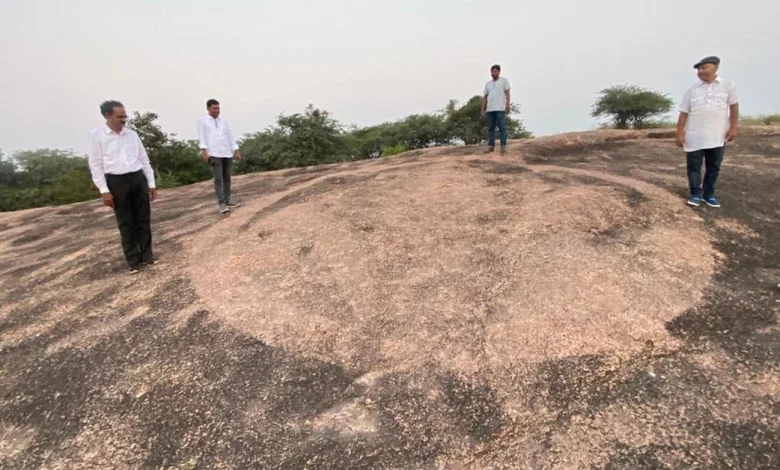Daily Current Affairs for UPSC
‘3,000-year-old Iron Age’ Geoglyph Circle Discovered in Telangana
Syllabus- Ancient Indian History [ GS Paper-1]

Context- A geoglyph circle said to be 3000 years old was recently discovered in Telangana.
Key Highlights
- Location: The geoglyph was found on the outskirts of Mudichu Thalapalli in the Medchal-Malkajgiri district of Telangana.
- Features: Carved into a low granite hill, the geoglyph is 7.5 meters in diameter and has a perfect round shape.
- There is a 30 centimeter wide border around the circle and two triangles inside the circle.
- Period: The geoglyph has been dated to the Iron Age, precisely around 1000 BC.
- Significance: Archaeologists have suggested that this circle could have served as a model for megalithic communities in the design of circular tombs.
- The newly discovered geoglyph shows the artistic skills and etching techniques of the Iron Age inhabitants of Telangana
- Archaeologists termed it as the first of its kind find in Telangana. Tourism Potential:
- The site could be developed as an archaeological attraction comparable to the famous Konkan petroglyphs of the Ratnagiri belt in Maharashtra.
- The place is just 30-40 km from Hyderabad and Secunderabad, so it is easily accessible for tourists.
What is a geoglyph?
- A geoglyph is a work of art created by placing or moving objects on the landscape.
- These objects are usually stones or earth.
- These are intentionally man-made designs.
- They are usually made by removing or cleaning sand or stones, or sometimes by adding stones.
- It creates contrast between the figure and the ground, which improves visibility.
Discovery of rock shelters and groves
- The team also identified several grooves that they believe date back to the Neolithic period, 4000 BC. and which are five meters away from the geoglyph.
- In addition, they found three prehistoric rock shelters decorated with bulls, deer, piglets and masked human figures within one kilometer of the geoglyph spot.
- According to the group, these works of art originate from the Mesolithic and Megalithic periods.
Prehistoric period in India
- Information: The colonization of India by humans spans at least half a million years and is divided into two major periods viz.
- Prehistoric (before the birth of writing) and Historical (after writing).
- The prehistoric era is further divided into the stone, bronze and iron ages. The Stone Age is further divided into Paleolithic, Mesolithic and Neolithic.
Stone Age:
- As the name suggests, technology during these periods was mostly based on stone.
- Economically, the Paleolithic and Mesolithic represented a nomadic, hunting and gathering way of life.
- The Neolithic represented a well-established, food-producing way of life.
- Later, copper was introduced as a new material and this period was called the Chalcolithic period.
- Agriculture: The invention of agriculture, which occurred approximately 8,000 years ago, caused dramatic changes in the economy, technology, and demography of human communities.
- During the hunting-gathering phase, the habitat of humans was mostly in hilly, rocky and forested areas where there were abundant natural plant and animal food sources.
- With the introduction of agriculture, it moved to flood plains with fertile soil and year-round water availability.
Bronze Age:
- The first urbanization took place during the Bronze Age in the arid and semi-arid region of northwestern India in the valleys of the Indus and Saraswati rivers, the latter represented by the now dry Ghaggar-Hakra basin.
- This urbanization is known as the Indus or Harappa Civilization, which flourished between 3500 and 1500 BC.
- Elsewhere in India, Neolithic and Chalcolithic farmers and Mesolithic hunter-gatherers lived during this period.
Iron Age:
- When iron technology was introduced about 3000 years ago, the focus of development shifted eastwards towards the Indo-Gangetic rift and the Ganges valley.
- The most prominent cultures of that period were Painted Gray Pottery and Northern Black Polished Ware.
- Janapadas arose during this period and gave birth to 16 Mahajanapadas.
Source: The Hindu





.png)



